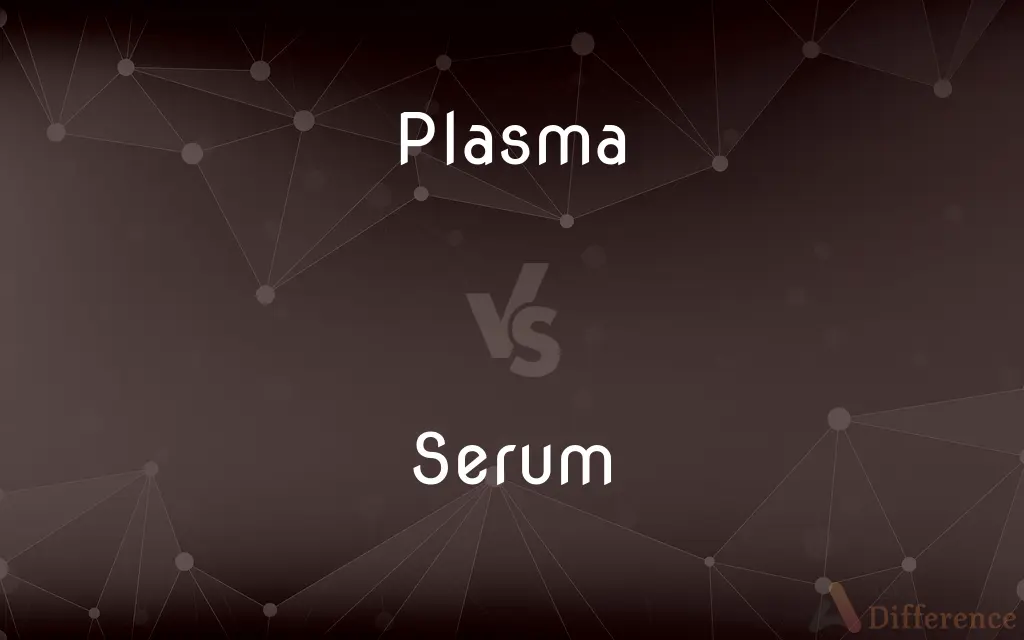Plasma vs. Serum — What's the Difference?
By Tayyaba Rehman & Fiza Rafique — Updated on March 15, 2024
Plasma is the liquid component of blood with clotting factors, while serum is plasma without these factors.

Difference Between Plasma and Serum
Table of Contents
ADVERTISEMENT
Key Differences
Plasma is a straw-colored, clear liquid that makes up about 55% of blood volume and is crucial for transporting nutrients, hormones, and proteins throughout the body. It contains water, electrolytes, nutrients, and proteins, including clotting factors that help the blood to clot when necessary. Serum, on the other hand, is the fluid that remains after the blood has clotted and the clotting factors have been removed. It is essentially plasma without the clotting factors.
Serum is used in various diagnostic tests and is important for its content of antibodies, which are essential in the immune response. While plasma is involved in clotting mechanisms, serum provides information about the body's immune status and protein levels.
Despite their similarities, the key difference lies in the presence of clotting factors: plasma contains them, whereas serum does not. This distinction is crucial in medical and clinical settings, where plasma might be used for treatments that require clotting factors, such as in clotting disorders, while serum is often used for diagnostic tests to assess the immune system, infections, and protein levels.
The process of obtaining each differs: plasma is obtained by centrifuging blood that has been treated with an anticoagulant to prevent clotting, while serum is obtained by allowing the blood to clot naturally before centrifuging to separate the serum. This difference in processing affects their usage in medical tests and treatments.
In terms of medical and research applications, plasma is often used in therapies that require clotting factors, such as in the treatment of hemophilia, whereas serum is used more in diagnostic laboratories for blood tests to measure things like hormone levels, mineral content, and the presence of drugs or toxins.
ADVERTISEMENT
Comparison Chart
Definition
The liquid component of blood with clotting factors
Plasma without clotting factors
Composition
Water, proteins (including clotting factors), electrolytes, nutrients
Water, proteins (excluding clotting factors), electrolytes, nutrients
Function
Transports nutrients, hormones, helps in clotting
Used in diagnostic tests, immune system analysis
Obtaining
Centrifugation of anticoagulated blood
Centrifugation of clotted blood
Applications
Treatments requiring clotting factors, volume expansion
Diagnostic tests, immunology
Compare with Definitions
Plasma
Plasma is the largest component of human blood, comprising about 55% of its overall content.
Donating plasma can significantly help patients with clotting disorders.
Serum
Serum is the component of blood that remains after coagulation, devoid of cells and clotting factors.
Serum is often used in laboratory tests to measure liver enzymes.
Plasma
Plasma serves as a transport medium for glucose, lipids, metabolic waste products, and carbon dioxide.
Plasma carries carbon dioxide to the lungs for it to be exhaled.
Serum
Serum is used in blood typing, diagnostic tests, and immunology studies.
Serum analysis can reveal a lot about a person's health status.
Plasma
It contains water, electrolytes, and proteins, including clotting factors and antibodies.
The proteins in plasma play various roles, from clotting to fighting infections.
Serum
It contains antibodies, making it crucial for serological tests to detect immune responses.
Measles immunity can be confirmed by detecting specific antibodies in the serum.
Plasma
It is obtained by centrifuging blood treated with an anticoagulant.
Plasma is separated from the blood cells without the blood clotting.
Serum
It is obtained by allowing blood to clot naturally before centrifuging.
After the blood clots, the clear liquid that remains is the serum.
Plasma
Plasma transfusions are used in medicine to treat conditions such as hemophilia and other clotting disorders.
Plasma transfusions can be lifesaving for patients with severe bleeding.
Serum
Serum is essential in diagnostic laboratories for biochemical analyses.
Serum levels of various substances can indicate different diseases.
Plasma
The clear, yellowish fluid portion of blood, lymph, or intramuscular fluid in which cells are suspended. It differs from serum in that it contains fibrin and other soluble clotting elements.
Serum
The clear yellowish fluid obtained upon separating whole blood into its solid and liquid components after it has been allowed to clot. Also called blood serum.
Plasma
Blood plasma, especially when sterilized and depleted of cells for transfusion.
Serum
Blood serum from the tissues of immunized animals, containing antibodies and used to transfer immunity to another individual.
Plasma
Protoplasm or cytoplasm.
Serum
Watery fluid from animal tissue, such as that found in edema.
Plasma
The fluid portion of milk from which the curd has been separated by coagulation; whey.
Serum
Whey.
Plasma
(Physics) An electrically neutral, highly ionized phase of matter composed of ions, electrons, and neutral particles. It is distinct from solids, liquids, and gases.
Serum
The clear yellowish liquid obtained upon separating whole blood into its solid and liquid components after it has been allowed to clot.
Plasma
Of or relating to a flat-panel display used in televisions, made up of an array of tiny cells each containing a gaseous mixture of xenon and neon that is changed into a plasma state to illuminate a phosphor coating on the inside of the cell.
Serum
Blood serum from the tissues of immunized animals, containing antibodies and used to transfer immunity to another individual.
Plasma
(physics) A state of matter consisting of partially ionized gas and electrons.
Serum
A watery liquid from animal tissue, especially one that moistens the surface of serous membranes or that is exuded by such membranes when they become inflamed, such as in edema or a blister.
Plasma
(hematology) A clear component of blood or lymph containing fibrin.
Serum
The watery portion of certain animal fluids like blood, milk, etc; whey.
Plasma
(hematology) Blood plasma, free of suspended cells, used in transfusions.
Serum
(skincare) An intensive moisturising product to be applied after cleansing but before a general moisturiser.
Plasma
(mineralogy) A variety of green quartz, used in ancient times for making engraved ornaments.
Serum
The watery portion of certain animal fluids, as blood, milk, etc.
Plasma
A mixture of starch and glycerin, used as a substitute for ointments.
Serum
Watery fluid of the blood that resembles plasma but contains fibrinogen
Plasma
A visual effect in which cycles of changing colours are warped in various ways to give the illusion of liquid organic movement.
Plasma
A variety of quartz, of a color between grass green and leek green, which is found associated with common chalcedony. It was much esteemed by the ancients for making engraved ornaments.
Plasma
The viscous material of an animal or vegetable cell, out of which the various tissues are formed by a process of differentiation; protoplasm.
Plasma
Unorganized material; elementary matter.
Plasma
A mixture of starch and glycerin, used as a substitute for ointments.
Plasma
Same as blood plasma.
Plasma
A state of matter in which charged particles such as electrons and atomi nuclei have sufficiently high energy to move freely, rather than be bound in atoms as in ordinary matter; it has some of the properties of a gas, but is a conductor of electricity.
Plasma
Colorless watery fluid of blood and lymph containing no cells and in which erythrocytes and leukocytes and platelets are suspended
Plasma
A green slightly translucent variety of chalcedony used as a gemstone
Plasma
(physical chemistry) a fourth state of matter distinct from solid or liquid or gas and present in stars and fusion reactors; a gas becomes a plasma when it is heated until the atoms lose all their electrons, leaving a highly electrified collection of nuclei and free electrons;
Particles in space exist in the form of a plasma
Common Curiosities
What is the main difference between plasma and serum?
The main difference is that plasma contains clotting factors, while serum does not.
Can plasma be used in medical treatments?
Yes, plasma is often used in treatments that require clotting factors, such as in clotting disorders.
What is serum used for?
Serum is used in diagnostic tests, blood typing, and to measure immune responses.
Is serum or plasma used for blood typing?
Serum is typically used for blood typing and other serological tests.
Can donating plasma affect the donor's health?
Plasma donation is generally safe, but donors may sometimes experience minor side effects like dehydration or fatigue.
Are there any risks involved in serum testing?
Serum testing is minimally invasive and generally very safe, with the primary risk being minor bruising or discomfort at the blood draw site.
Can serum be used in transfusions?
Serum is not typically used for transfusions; instead, specific components like red blood cells, platelets, or plasma are used.
How is plasma obtained?
Plasma is obtained by centrifuging blood that has been treated with an anticoagulant to prevent clotting.
Why is plasma important in the body?
Plasma transports nutrients, hormones, and proteins throughout the body, and plays a key role in clotting and immune responses.
What is the role of electrolytes in plasma?
Electrolytes in plasma help regulate nerve and muscle function, hydrate the body, balance blood acidity and pressure, and help rebuild damaged tissue.
How often can a person donate plasma?
Regulations vary, but in many places, people can donate plasma more frequently than whole blood, often up to twice a week.
How do clotting factors in plasma contribute to hemostasis?
Clotting factors in plasma are essential for the blood clotting process, helping to stop bleeding by forming clots at sites of injury.
Are there any diseases diagnosed by analyzing serum?
Yes, many diseases can be diagnosed by analyzing the content of the serum, including liver diseases, kidney diseases, and certain infections.
How does the body replace donated plasma?
The body can quickly replace the plasma donated, usually within 24-48 hours, whereas it takes several weeks to replace the cells.
What is the significance of antibodies in serum?
Antibodies in serum are crucial for the immune system to identify and neutralize pathogens like bacteria and viruses.
Share Your Discovery

Previous Comparison
Moon vs. Luna
Next Comparison
Anticipate vs. AwaitAuthor Spotlight
Written by
Tayyaba RehmanTayyaba Rehman is a distinguished writer, currently serving as a primary contributor to askdifference.com. As a researcher in semantics and etymology, Tayyaba's passion for the complexity of languages and their distinctions has found a perfect home on the platform. Tayyaba delves into the intricacies of language, distinguishing between commonly confused words and phrases, thereby providing clarity for readers worldwide.
Co-written by
Fiza RafiqueFiza Rafique is a skilled content writer at AskDifference.com, where she meticulously refines and enhances written pieces. Drawing from her vast editorial expertise, Fiza ensures clarity, accuracy, and precision in every article. Passionate about language, she continually seeks to elevate the quality of content for readers worldwide.















































